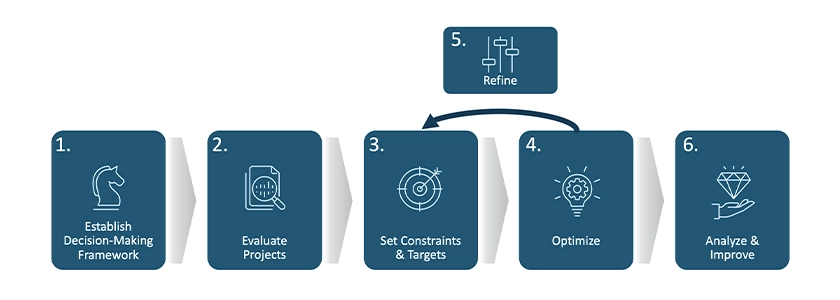Six Steps to Maximize Capital Efficiency in Chemical Manufacturing
Maximizing capital efficiency is imperative for any organization looking to gain a competitive advantage, and the first step in creating value is to develop capital plans that drive strategy.
In this webinar, Mark Schulz, a leader in digital transformation, moderated a panel discussion featuring Dan Coombs, former EVP of LyondellBassell, and Phil Jones, Global Vice President, Business Development at Copperleaf, to explore how leading organizations are changing the way they make capital expenditure (CapEx) decisions.
Industry Challenges and Trends
The chemical industry is undergoing unprecedented change. Margins are being squeezed by global competition, yet investors, regulators, and consumers are placing increasing pressure on chemical companies to meet new and evolving Environmental, Social, and Governance (ESG) commitments. Organizations must strike the right balance between cost-effectively managing today’s business and investing to meet future demands.
Having a process for managing risk consistently and based on value is critical, because every dollar a company invests should create value.
Dan Coombs
Former EVP
LyondellBassell
In this video clip, Dan discusses how chemical companies need to develop capital plans that manage risk and cost effectively, balance ESG and business goals, and improve decision-making agility to ensure CapEx decisions are aligned to strategic objectives and consider the ever-changing economic environment.
Six Steps to Develop the Highest-Value Capital Plans
During the webinar, Phil described a six step capital planning process used by some of the world’s leading asset-intensive organizations:

- Establish a Decision-Making Framework: Develop a common economic scale to ensure decision making is aligned with corporate strategy
- Evaluate Projects: Use the framework to evaluate every project across the organization on a common economic scale to understand the relative costs, resource requirements, and benefits
- Set Constraints and Targets: Establish business constraints (e.g. budget, resources, timing) and targets (e.g. risk reduction, reliability improvements, cash flow, etc.) in order to allocate capital to the right projects at the right time
- Optimize: Determine the best combination of projects that creates the most value based on the organization’s defined strategic objectives, constraints, and targets
- Refine: Create multiple planning scenarios to explore the impact of different levels of capital and resource allocation, and varying economic conditions
- Analyze and Approve: Compare, contrast, and communicate the value, timing, risks, and costs of different investment strategies to build consensus among stakeholders and agree on the best path forward
In this video clip, Dan talks about how understanding plan deliverability, risk exposure, and impact on strategy are key to developing a realistic, executable plan that will drive the most value to the organization.
What is Continuous Planning and Why is it Important?
Many organizations approach capital planning as an annual event. However, a plan that was approved three months ago may require significant changes due to unforeseen circumstances, such as emergent work, regulatory changes, cost overruns, and schedule slippages. In today’s business environment, there is mounting pressure on organizations to be able to adapt and justify their plans quickly and continuously.
A continuous planning process provides the ability to compare planned versus actual performance, enabling organizations to understand the variances between budgeted vs. actual costs, and expected vs. actual benefits delivered. This, in turn, allows organizations to dynamically re-optimize the plan and redirect available resources to the projects which deliver the most value.
Having a tool that is effective, efficient, and continuous can create a lot of value around capital planning and execution.
Dan Coombs
Former EVP
LyondellBassell
In the following video clip, Dan explains how moving from batch planning to a continuous planning process enables organizations to create better plans with less effort, and free up time from the mechanics of planning to address bigger strategic questions and focus on executional excellence.
For more insights on how your organization can create investment plans that maximize capital efficiency, watch the full webinar.
Reach out to Copperleaf to learn more.

